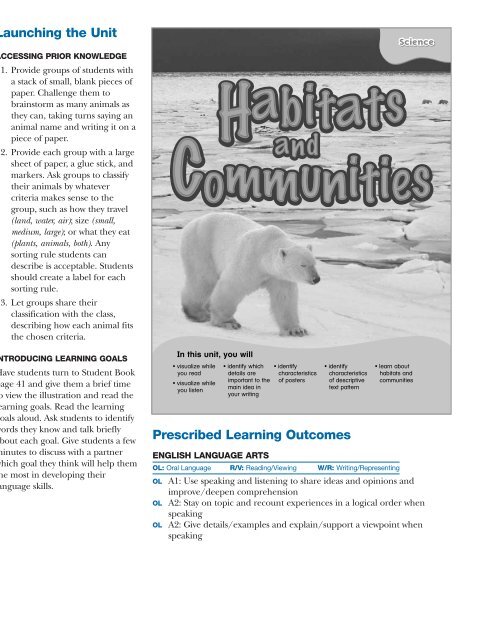Teacher's Resource - Nelson Education
Teacher's Resource - Nelson Education
Teacher's Resource - Nelson Education
Create successful ePaper yourself
Turn your PDF publications into a flip-book with our unique Google optimized e-Paper software.
Launching the Unit<br />
ACCESSING PRIOR KNOWLEDGE<br />
1. Provide groups of students with<br />
a stack of small, blank pieces of<br />
paper. Challenge them to<br />
brainstorm as many animals as<br />
they can, taking turns saying an<br />
animal name and writing it on a<br />
piece of paper.<br />
2. Provide each group with a large<br />
sheet of paper, a glue stick, and<br />
markers. Ask groups to classify<br />
their animals by whatever<br />
criteria makes sense to the<br />
group, such as how they travel<br />
(land, water, air); size (small,<br />
medium, large); or what they eat<br />
(plants, animals, both). Any<br />
sorting rule students can<br />
describe is acceptable. Students<br />
should create a label for each<br />
sorting rule.<br />
3. Let groups share their<br />
classification with the class,<br />
describing how each animal fits<br />
the chosen criteria.<br />
INTRODUCING LEARNING GOALS<br />
Have students turn to Student Book<br />
page 41 and give them a brief time<br />
to view the illustration and read the<br />
learning goals. Read the learning<br />
goals aloud. Ask students to identify<br />
words they know and talk briefly<br />
about each goal. Give students a few<br />
minutes to discuss with a partner<br />
which goal they think will help them<br />
the most in developing their<br />
language skills.<br />
In this unit, you will<br />
• visualize while<br />
you read<br />
• visualize while<br />
you listen<br />
• identify which<br />
details are<br />
important to the<br />
main idea in<br />
your writing<br />
• identify<br />
characteristics<br />
of posters<br />
• identify<br />
characteristics<br />
of descriptive<br />
text pattern<br />
Prescribed Learning Outcomes<br />
• learn about<br />
habitats and<br />
communities<br />
Science<br />
ENGLISH LANGUAGE ARTS<br />
OL: Oral Language R/V: Reading/Viewing W/R: Writing/Representing<br />
OL A1: Use speaking and listening to share ideas and opinions and<br />
improve/deepen comprehension<br />
OL A2: Stay on topic and recount experiences in a logical order when<br />
speaking<br />
OL A2: Give details/examples and explain/support a viewpoint when<br />
speaking<br />
12 <strong>Nelson</strong> Literacy 4 Teacher’s <strong>Resource</strong>: Habitats and Communities<br />
NEL

















